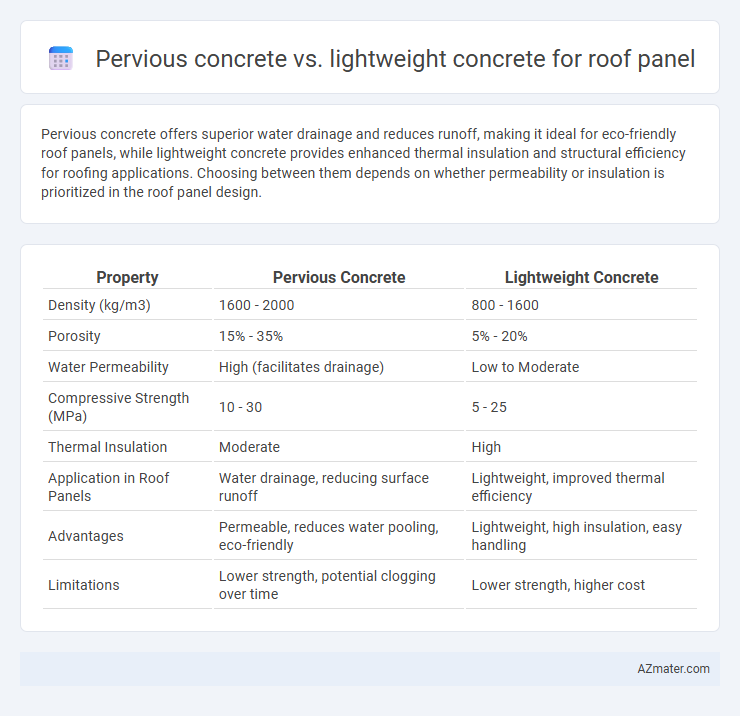Pervious concrete offers superior water drainage and reduces runoff, making it ideal for eco-friendly roof panels, while lightweight concrete provides enhanced thermal insulation and structural efficiency for roofing applications. Choosing between them depends on whether permeability or insulation is prioritized in the roof panel design.
Table of Comparison
| Property | Pervious Concrete | Lightweight Concrete |
|---|---|---|
| Density (kg/m3) | 1600 - 2000 | 800 - 1600 |
| Porosity | 15% - 35% | 5% - 20% |
| Water Permeability | High (facilitates drainage) | Low to Moderate |
| Compressive Strength (MPa) | 10 - 30 | 5 - 25 |
| Thermal Insulation | Moderate | High |
| Application in Roof Panels | Water drainage, reducing surface runoff | Lightweight, improved thermal efficiency |
| Advantages | Permeable, reduces water pooling, eco-friendly | Lightweight, high insulation, easy handling |
| Limitations | Lower strength, potential clogging over time | Lower strength, higher cost |
Introduction to Pervious and Lightweight Concrete
Pervious concrete is a highly porous material designed to allow water to pass through, making it ideal for roof panels requiring effective drainage and reduced runoff. Lightweight concrete incorporates lightweight aggregates like expanded clay or shale, offering reduced density and enhanced thermal insulation for roofing applications. Both materials provide unique benefits, with pervious concrete promoting water permeability and lightweight concrete improving structural efficiency and energy savings.
Key Material Properties Comparison
Pervious concrete offers superior water permeability and high porosity suited for drainage in roof panels, while lightweight concrete excels in reducing dead load due to its lower density and enhanced thermal insulation properties. The compressive strength of lightweight concrete typically ranges from 3 to 28 MPa, whereas pervious concrete varies between 2 to 20 MPa depending on void content. Lightweight concrete also demonstrates better fire resistance and sound insulation, making it a preferred choice for energy-efficient and durable roofing applications.
Structural Performance on Roof Panels
Pervious concrete offers excellent drainage capabilities while maintaining moderate compressive strength suitable for roof panels with load requirements up to 20 MPa. Lightweight concrete provides superior structural performance with higher strength-to-weight ratios, typically reaching compressive strengths of 25-40 MPa, reducing dead loads on roof structures. The choice between the two depends on balancing permeability needs with load-bearing capacity and overall roof panel durability.
Thermal Insulation Capabilities
Pervious concrete offers moderate thermal insulation due to its porous structure allowing air circulation, while lightweight concrete provides superior thermal insulation owing to its low density and entrapped air pockets that reduce heat transfer. The thermal conductivity of lightweight concrete typically ranges between 0.1 to 0.3 W/m*K, significantly lower than pervious concrete, which averages around 0.7 to 1.2 W/m*K. For roof panels, lightweight concrete enhances energy efficiency by minimizing heat gain, making it more effective for thermal insulation compared to pervious concrete.
Water Permeability and Drainage Efficiency
Pervious concrete for roof panels excels in water permeability, allowing efficient drainage and minimizing surface water accumulation, which reduces the risk of leakage and structural damage. Lightweight concrete, while offering excellent thermal insulation and reduced load on structural elements, has lower water permeability and typically requires additional drainage solutions to prevent water retention. Selecting pervious concrete enhances roof panel drainage efficiency, making it ideal for rainwater management in sustainable building designs.
Weight and Load Implications
Pervious concrete offers a lightweight alternative to traditional concrete with a density typically ranging from 1600 to 1800 kg/m3, reducing dead load on roof structures and enhancing drainage capabilities. Lightweight concrete, often made with expanded clay or shale, has densities between 1400 and 2000 kg/m3, significantly lowering structural load and improving thermal insulation for roof panels. Choosing between pervious and lightweight concrete affects load-bearing capacity, with pervious concrete balancing strength and permeability, while lightweight concrete prioritizes weight reduction and insulation performance.
Durability and Longevity
Pervious concrete roof panels offer excellent durability through enhanced drainage, reducing water retention and minimizing freeze-thaw damage, which extends their longevity in varying climates. Lightweight concrete panels maintain structural integrity with lower density, providing resistance to cracking and thermal stress that supports long-term performance in roof applications. Both materials enhance roof durability, but pervious concrete excels in moisture management while lightweight concrete offers superior insulation and impact resistance.
Cost Analysis and Economic Considerations
Pervious concrete offers enhanced drainage properties but generally comes with higher initial material and installation costs compared to lightweight concrete, which is favored for its lower density and thermal insulation at a more affordable price point. Lightweight concrete reduces structural load, potentially lowering foundation costs and long-term energy expenses, making it economically advantageous for roof panels in various climates. Cost analysis should factor in lifecycle expenses, including maintenance and energy efficiency, where lightweight concrete often presents better overall savings despite marginally higher upfront costs than standard concrete.
Suitability for Different Climatic Conditions
Pervious concrete offers superior drainage and cooling benefits, making it ideal for regions with heavy rainfall and hot climates by reducing water runoff and surface temperature. Lightweight concrete provides excellent thermal insulation and reduces structural load, enhancing performance in cold or earthquake-prone areas by retaining heat and increasing durability. Selecting the right material for roof panels depends on local climate factors such as precipitation, temperature variations, and seismic activity to optimize energy efficiency and structural integrity.
Recommendations for Selecting the Right Concrete Type
Pervious concrete is ideal for roof panels requiring superior drainage and environmental sustainability due to its high permeability, making it suitable for green roofing systems and reducing water runoff. Lightweight concrete, with its reduced density and excellent thermal insulation properties, is recommended for roof panels where load reduction and energy efficiency are prioritized. Selecting between pervious and lightweight concrete depends on the specific project needs such as structural load capacity, thermal performance, and water management goals.

Infographic: Pervious concrete vs Lightweight concrete for Roof panel
 azmater.com
azmater.com